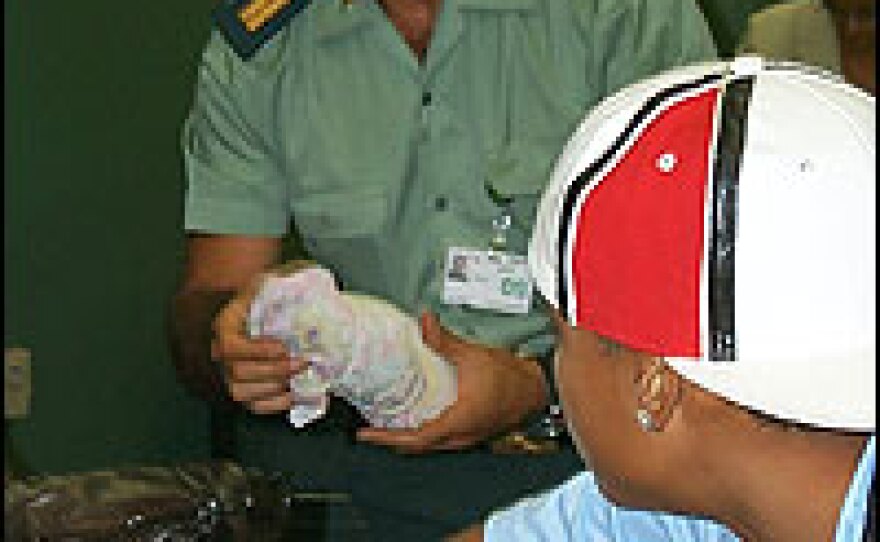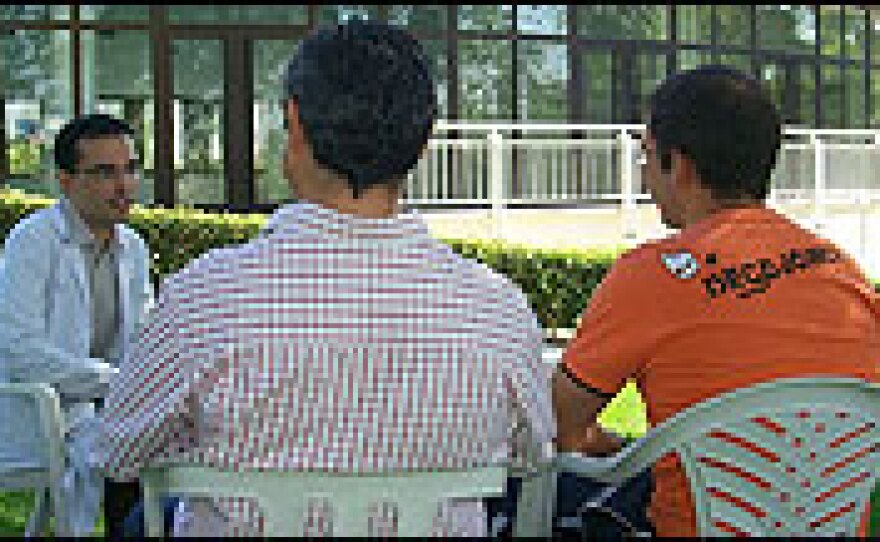

For the past decade, cocaine has become a rapidly growing problem in Europe.
Around 10 million Europeans, or about three percent of the population, say they've tried cocaine at least once in their lifetimes.
In Spain and Britain, cocaine consumption is comparable to that of the United States. Spain is also the European gateway for the drug.
Last year, more than 8,000 people were jailed in Spain for cocaine trafficking. Law enforcement officials say the country has also become a key European money laundering center for Colombian cocaine cartels.
Scanning for the Drug
At Madrid's Barajas airport, a black Belgian shepherd sniffs a few suspicious bags that are being unloaded from a flight from Caracas, Venezuela.
Then in the arrivals hall, a plain-clothes narcotics agent looks for suspicious bags. He spots one piece of suspect luggage. It's a carry-on, and it's the only bag the passenger appears to have brought on this intercontinental flight.
The passenger, a woman in jeans and short black hair, is led into a side room. Even the agent is surprised by what the x-ray machine shows.
There are hidden compartments all around the insides of the bag, which is otherwise empty. The agent orders the passenger to open it, and he takes out sealed bags filled with white powder.
"Do you know what this is? This is cocaine," he says to the passenger. "You are under arrest."
Less than a minute later, another passenger is brought in from the Caracas flight. And it's the same story. His bag has a false bottom that conceals cocaine worth hundreds of thousands of dollars on the European street.
Increased Cocaine Trafficking in Spain
Back in the arrivals lounge, Sgt. Jose Luis Queija scans the room with his deep-set eyes. Queija heads the airport anti-narcotics squad for the Guardia Civil, Spain's paramilitary police force. He's fought the illicit drugs trade long enough to be jaded.
"In almost 30 years, I've seen it all," Queija says. "We've caught people with drugs in wheelchairs, bicycles, inside their bodies, dogs, in animal cages, in tropical fruits, even in carnation stems."
Queija keeps a collection of confiscated containers, which includes a bowling ball, a bottle of shaving cream, statuettes and liquor bottles. He used to be impressed by the traffickers' ingenuity.
"But lately, I have to say that that sense of ingenuity is being lost, because now there's just loads of it coming," Queija says. "Sometimes they don't even bother to make hidden compartments."
Already this year, police at the airport have seized more than 2 1/2 tons of cocaine — nearly the amount seized for all of 2006.
Diversifying Smuggling Routes
Spain already accounts for nearly half of the more than 70 tons of cocaine seized each year across the European Union. Queija says Spain is a natural European gateway because of its cultural ties to Latin America. But increasing crackdowns are forcing smugglers to diversify their routes, he says.
"What's really hot now is West Africa, Cape Verde, Senegal and that area." Queija says. "You get containers of drugs unloaded there, and it's brought to Europe."
By transferring the drugs onto smaller boats, the traffickers can skirt the patrols along the lengthy coastlines of Northwest Africa and the Iberian Peninsula. European law enforcement officials suspect that cocaine rings are working with hashish smugglers on the Moroccan coast.
They use power boats to zip across the Strait of Gibraltar into Spain, where cocaine can earn the smuggler big bucks. And it has also been fueling the party scene in beach resorts like Ibiza and in cities like Madrid.
Drugs' Popularity with Partygoers
Julian Vicente is an expert at the European Monitoring Centre for Drugs and Drug Addiction in Lisbon. He points to the drug's popularity for party goers in Spain and Britain.
"Cocaine and also other stimulants ... are very popular among people going to discos or parties or clubs, etc. And, well, in these two countries it seems there's a big industry on nightlife, on discos and so on."
But Spaniards' increasing appetite for coke has led to a need for clinics that deal exclusively with cocaine addiction. Experts say that the typical addict is a young professional male, between the ages of 15 and 34 years old.
The 'Acceptable' Drug
In Madrid's San Juan de Dios clinic, 29-year-old Santiago releases his nervous energy by pounding a punching bag in the clinic's gym. He's a psychology Ph.D. student, and he doesn't want his last name made public — in the hopes of salvaging his career.
Santiago got excellent grades and only used cocaine at clubs on the weekends. Then, he tried crack one afternoon several years ago.
"I looked like the ideal kid, the good student. I went out and nobody suspected anything," Santiago says. "But I was smoking crack every afternoon in a ghetto with North African immigrants."
Santiago's parents grew up during the Franco dictatorship. Many in his parent's generation are at a loss as to how to prevent their kids from trying drugs, especially, he says, when it's the thing to do.
"It's a form of consumption that's accepted by society. We see it in the media," Santiago says. "Just like performing artists in the United States use it, in Spain, we too see how they go in and out of detox — apparently, without problems. And they are adored by the media."
Spain is often called the California of Europe. Compared to Calvinist northern Europe, appearances count in Spain, according to Javier, a 45-year-old trial lawyer who is also undergoing treatment at the clinic.
"You had to have a nice suit, a nice car, and nice watch — and all of that and your little bag of cocaine," he says.
Javier says revealing his surname would ruin his career. His colleagues think he's in treatment for depression. At the office, he used to get cocaine delivered by a fake client who would be led in by his secretary.
"He would come in, and he was the pusher," Javier says. "He brought me the drugs."
Addiction Treatment
The therapy at the San Juan de Dios clinic relies a lot on peer support and self-examination. Santiago walks over to the full-length mirror in the gym.
"It's very hard to stand in front of the mirror and look yourself in the eyes and say things as they are: I'm a drug addict, and I want to get out of drugs," he says.
It certainly won't be easy. He's at the clinic for the second time. Doctors at this clinic say that's not unusual. The success rate in overcoming addiction is 30 percent.
So far, Spain and Britain and a few other countries account for most of the spike in cocaine use. But experts worry that with the cheap availability of the drug and the new trafficking routes, the problem could get much worse soon.
Copyright 2022 NPR. To see more, visit https://www.npr.org. 9(MDAzMjM2NDYzMDEyMzc1Njk5NjAxNzY3OQ001))







